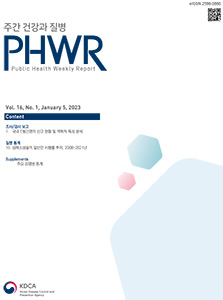Current Issue
Vol.16 No.1, January 05, 2023
-
Surveillance Reports 2023-01-05
 0
0
 1863
1863
 551
551
Surveillance and Epidemiological Characteristics of Hepatitis E in the Republic of Korea
Jaehwa Chung, Soonryu Seo, Eunkyung Park, Seunghee Cho, Minam Lee, Jin Gwack*
Public Health Weekly Report 2023; 16(1): 1-15 https://doi.org/10.56786/PHWR.2023.16.1.1 Abstract
AbstractHepatitis E virus (HEV) causes acute hepatitis that is mainly transmitted through contaminated water or raw food intake and is classified as a food and waterborne disease. Since July 2020, it has been designated as a class 2 notifiable infectious disease and managed under mandatory surveillance. In this study, the occurrence patterns and epidemiological characteristics of HEV were analyzed using reported data and epidemiological investigation data from the Korea Disease Control and Prevention Agency’s data after mandatory surveillance. From July 2020 to June 2022, the number of reported cases gradually increased, and the reported rate was relatively higher in Gangwon-do compared to that of other regions. The epidemiological investigation analysis showed that 84.5% of the reported individuals had abnormal liver function values, and the number of patients with symptoms was approximately 1.6 times higher than that of asymptomatic pathogen carriers. Regarding the regional differences identified in the reporting of HEV, an in-depth investigation is needed to determine the exact cause. Hepatitis E is a notifiable infectious disease under mandatory surveillance, but it is estimated that there will be a large number of hidden infections, due to the high rate of asymptomatic, low awareness, and unstandardized diagnostic methods. Therefore, it is necessary to actively guide and promote the government, along with the continuation of the discussions and research, to improve the HEV control measures.
-
QuickStats 2023-01-05
 0
0
 779
779
 259
259
Trends in Bystander Cardiopulmonary Resuscitation, 2008-2021
Public Health Weekly Report 2023; 16(1): 16-17 https://doi.org/10.56786/PHWR.2023.16.1.2

pp. 1433~1461
Most Keyword
?
What is Most Keyword?
- It is the most frequently used keyword in articles in this journal for the past two years.
Most Read
-
Waterborne and Foodborne Disease Outbreaks in the Republic of Korea, 2023
Myung-Jae Hwang, So Yeon Park, Hyungjun Kim, Se Jeong Yang, Sungchan Yang, Jin Seon Yang
Public Health Weekly Report 2025;18: 17-32 https://doi.org/10.56786/PHWR.2025.18.1.2 -
Implementation Plan for the Coronavirus Disease 2019 Vaccination for the 2024–2025 Season: Recommendations of the 6th Expert Committee on Immunization Practices
Hyewook Hwang, Wookeon Lee, Seohyeon Ahn, Young-Sook Choi, Seunghyun Lewis Kwon, Dongwoo Lee, Eun Hwa Choi, SokGoo Lee
Public Health Weekly Report 2025;18: 90-102 https://doi.org/10.56786/PHWR.2025.18.2.3
Editorial Office
+82-43-719-7569





 Full Text
Full Text Cite
Cite


